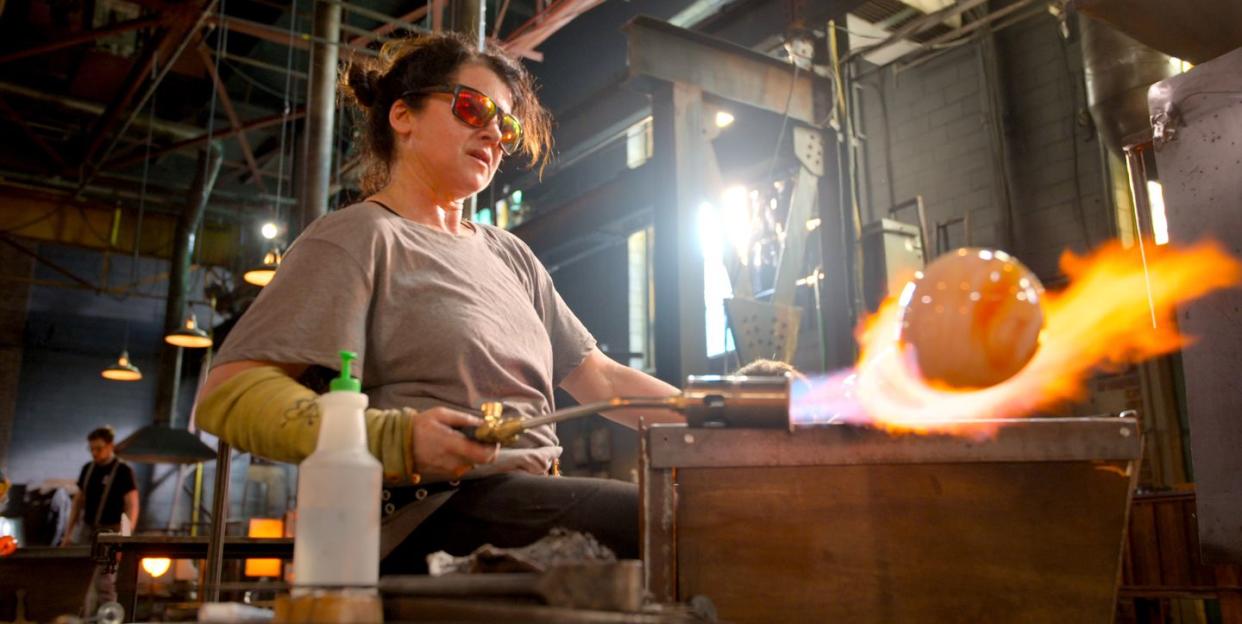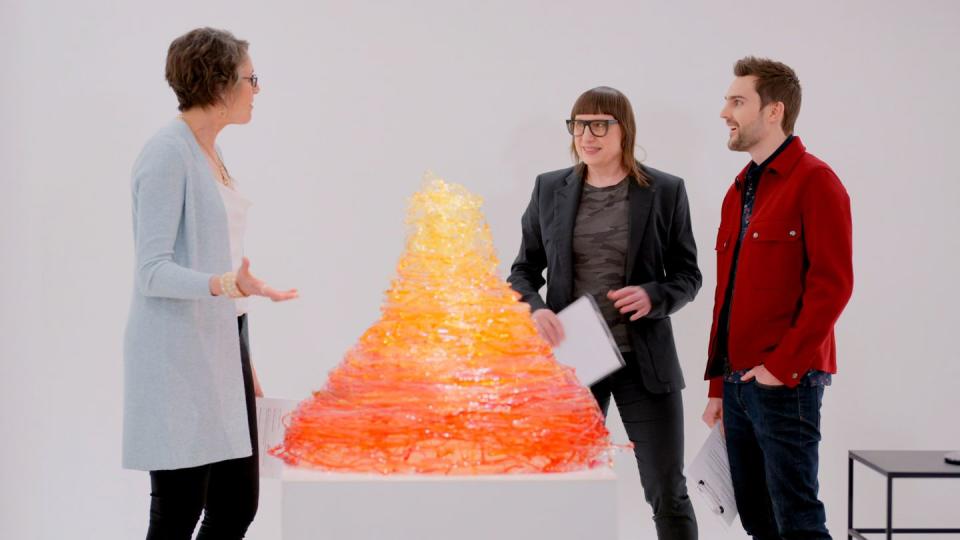“Blown Away” Is the Addictive Design Show You Should Be Watching Now

Certain disciplines are such natural fits with a reality-television format that they seem to beg for the voyeuristic presence of multiple camera angles. Consider the endless riffs on fashion (America’s Next Top Model, Project Runway, Next in Fashion), cooking (Top Chef, Chopped), and baking (Nailed It!, The Great British Baking Show) that have found enthusiastic and loyal audiences. And then there are fields that have not been previously associated with the prying lenses of videographers but end up being unexpectedly fertile territory for unscripted TV drama. Blown Away—the second season premieres today on Netflix—falls sturdily into the latter category.
The show follows 10 glassblowing contestants, gathered in what is deemed the largest hot shop in North America (it’s outside of Toronto) and competing for the title of “Best in Glass.” The winner receives $60,000 and a residency at the Corning Museum of Glass (the museum is exhibiting pieces from all 10 competitors to coincide with this new season). Here, the show’s presenter, Nick Uhas, a YouTube science content maker, and its resident evaluator and host, Katherine Gray, a glass artist and art professor, discuss the unlikely success of Blown Away.

ELLE Decor: What was your reaction when the producers approached you to host a reality competition show about...glassblowing?
Nick Uhas: A lot of my background up until this point has been through science and engineering. I had done some work with the Discovery Channel and the Weather Channel. There’s so much mystery in glass, and I was so excited to dive into it from the science standpoint of, What is this material? How do you manipulate this material? What makes the material do what it does? There’s so much interest about the medium itself that...well, I was blown away.
Katherine Gray: I was definitely nervous and apprehensive because it’s a small community, and I’m not really crazy about a lot of reality shows because they just get so competitive. The producers were pretty clear that that’s not how they wanted to portray the field—they wanted to preserve all the drama for the actual process of glassblowing—but I was still nervous until I saw the final product. I really had to put my faith in them that they were going to do what they said they would, and I think that they did.
ED: What is it about glassblowing that makes it a great fit for a competition format? Certainly, Nick, you have a background with reality TV, having competed on Big Brother and America’s Got Talent.
NU: I have so much empathy for these contestants: They’re not just doing this for fun, this is their whole life’s work. Some of these people have been professors for decades, and the style of glass they do is everything they do. So it’s not just, like, “Hey, I’m blowing glass, I hope I do well.” It’s like, “This is my everything. This is who I am and you are judging who I am.” So glassblowing lends itself really well to a reality competition for those reasons.
KG: It is very dramatic. You have this hot, molten liquid. It’s this combination of a dance and athleticism and artistry as well as just dangerous elements: You could burn or cut yourself at any minute. There’s an edge to the whole thing. There’s just so much about it that’s unlike anything else that people do. To see an artist working in a milieu like this with this kind of arcane knowledge that was invented by Romans 2,000 years ago—I think it’s pretty eye-opening. And it’s definitely a magical thing to watch.

ED: Did anything you learned about hosting this show in Season 1 affect your roles in the new season?
KG: When I saw the final version, I realized how little of the actual footage gets used. I realized that I didn’t necessarily have to be super concise or articulate all the time because they would always have lots of material to choose from, which is liberating. And then even in Season 1, we were always prompted to have both good and bad things to say about every piece—so that no matter what happened, they would have footage to build the story arc. There were definitely times when a piece was just spectacular and we were like, “What do you mean we have to say something negative? There’s nothing negative to say.”
NU: I am more educated now about glass, and that has allowed me to very quickly decide what might be difficult and where people should be rewarded, versus being a total layman and thinking, “I like this; it’s red.”
ED: As a total layperson, it was also funny to see how many off-color puns there are in the various glassblowing terms you use. I mean, you crown someone “Best in Blow” at the end of each episode, and there are the glory holes…
NU: Don’t forget the paddles and the punties!
KG: Every time I teach beginners and have to introduce the various names of the equipment, I have to preface everything with, “I understand that a glory hole has another connotation in another context...but here it is the oven we use to reheat in.” There are glory holes, there’s flashing—when you’re just reheating a piece in the glory hole. When you’re putting that neckline in, it’s called putting a neck in the piece, but it’s also called putting a jackline in, jacking in—that is euphemistic too.

ED: Tongue-in-cheek witticisms aside, were you surprised by the success of the show? There are so many great series that don’t get a second season.
NU: I think one of the reasons for its success was it was such a new thing in an overcrowded crazy market of redundant things. How many shows are there about the rich housewives of X? I’ve spent a lot of time in the YouTube world—if you have a video on your channel that gets four minutes of watch time, that’s really good. At the Corning Museum of Glass they have videos of people making glass; their average watch time is 1 hour and 15 minutes. So that tells you that people—much like with Bob Ross—really like to watch things get made of glass. Still, I was so pleasantly surprised by the reaction of the audience. I would be walking somewhere and someone would stop me and say, “Oh my gosh, you’re the guy from the glassblowing show!”
ED: Katherine, have you been recognized, too, outside the glassblowing community?
KG: I have, twice. It was right after the release of the first season. And it made me really nervous, like, Oh my God, is this what my life is going to be like now? But then that was it. It was a relief.
You Might Also Like


